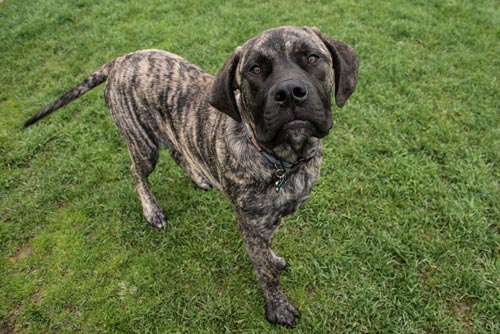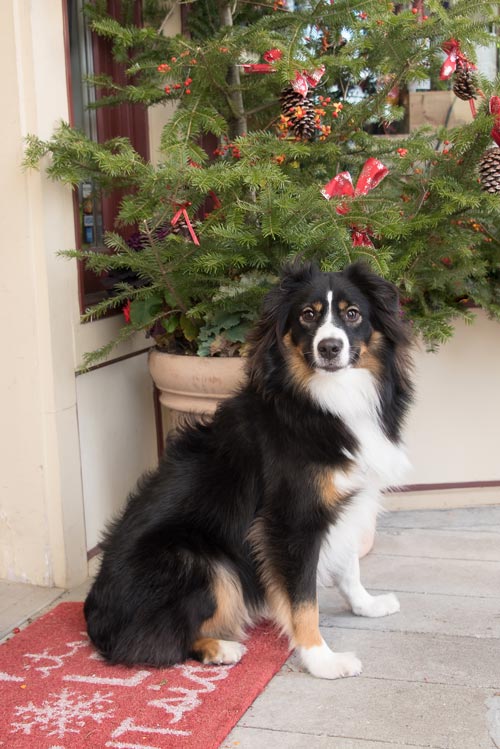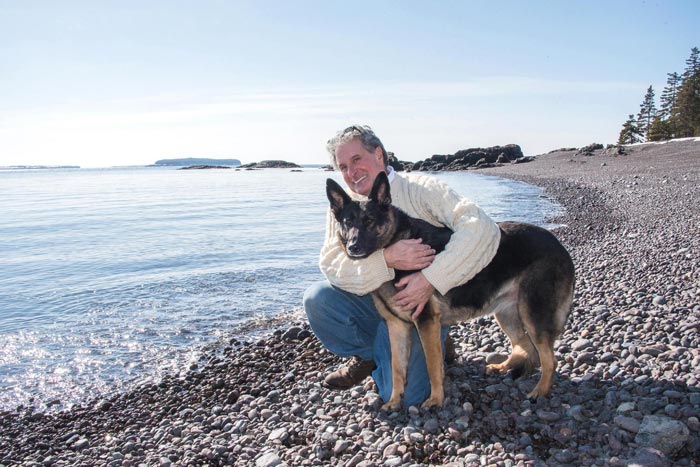Breaking Barriers of Abuse
In 2006, Hancock County resident Susan Walsh testified in front of the Agriculture Committee in support of LD 1881, an act to give judges the authority to protect pets as part of protection from abuse orders. Walsh, a domestic violence survivor, told her story about how her then-husband executed her elderly, deaf, and blind border collie. She also testified that he killed several sheep at the Ellsworth barn.
“It wasn’t just the cats and dogs I feared for. It was the sheep and the chickens,” Walsh told legislators. “I was terrified for their welfare. I knew if I left, he wouldn’t hesitate to kill them. He had done it before. I knew that any animal left behind would be dead in 24 hours.”
Unfortunately, she said, she was right. Walsh isn’t alone. Nationally, studies have shown that 48% of battered women delay leaving a dangerous situation due to fear for their pets’ safety.
Katie Hansberry, Maine state director of the Humane Society of the United States, testified before the Maine legislature appropriations committee on April 4 in favor of a bill adding pets to orders of temporary protection from abuse. In some cases, men are also affected by threats against family pets or animals.
“It is crucial to be able to get animals away from an abuser during the time when things are usually the most dangerous, namely when a victim leaves an abusive situation,” she said.
Maine is a leader in legal protections for animals in cases of domestic violence. In 2006, a landmark law enacted gave judges the power to include pets on permanent protection from abuse orders. In addition, it enables judges to impose penalties ranging from a fine to jail time if the order is violated.
Then in May, the 126th Maine Legislature took that one step further to amend the law and apply for temporary protection orders. LD 687, proposed by Maine Rep. Andrea Boland, D-Sanford, was sparked by a conversation with former probate judge and practicing lawyer Donna Bailey of Saco.
Bailey encouraged Boland to amend the law to protect farm animals, including horses and livestock, during the most dangerous time, when a person leaves. The protections extend to protect pets of stalking victims.
“I feel really honored that the judge would come to me for the presentation of this bill and that I had an opportunity to make what I hope will be an enormous improvement in the lives of abused people and pets,” Boland said, “They can be your anchor and love you unconditionally, providing great comfort. They don’t judge you or give you a hard time about much. It keeps us all a bit more humane to have pets in our lives.”
The Link Between Domestic Abuse & Family Animals
The American Veterinary Medical Association reports that 63% of Maine homes had at least one pet in 2011. Unfortunately, animals are often the targets of real and implied harm, especially in domestic violence. That is a reason that many people who are abused choose to stay in the relationship.
According to the Maine Coalition to End Domestic Violence, domestic violence is a pattern of coercive behavior used by a person against family, household members, or dating partners to gain power or control over the other party in a relationship. An abuser exerts control, experts say, by using family pets and animals as pawns and targets.
“The threat of harm may be physical or financial,” said Dr. David Cloutier, owner, and veterinarian at Veazie Veterinary Clinic, “In a domestic violence situation, we see that in particular, the abusers use the pets to control the victims in a situation,” Cloutier said. “Telling them that, ‘If you leave me I’m going to kill your cat,’ or ‘if you leave me, I’m going to hurt your dog.’”
In addition, he said, the abuser may hurt the animal in front of their partner or children as an outlet for their anger. The American Humane Association reports that 87% of the incidents of abuse happened in front of the partner and 75% in the presence of children.
“For many victims of domestic violence, pets are their one comfort,” said Gail Crowell, program coordinator for the Animal Welfare Society and chair of the York County Linkage Coalition. “Children, in particular, bond with pets because they are both so vulnerable. Leaving the animals is dangerous and can create unfair emotional leverage at a time when the victim is most vulnerable.”
The link between animal abuse and domestic violence has been studied extensively. It extends beyond the household. People who abuse animals, especially at a young age, are more likely to commit violence against people.
Serial killers, for example, often begin by maiming, killing, and dismembering animals. They start young. Pre-teen Jeffrey Dahmer searched for dead animals, then took them home to dissect them. He committed his first murder at age 18. John Wayne Gacy experimented on animals at age 11.
“Kids model what they see, for better or worse,” said Bangor child therapist, Nancy Webster, “When I talk with parents whose children were exposed to these situations, about 80% of the time the parent tells me that they didn’t see it or were asleep when it happened. Conversely, I talk to children, and they tell me word for word that ‘I watched out the window when Dad put the chain around the dog’s neck and dragged him down the street until he killed him.’ These memories stay with them. If children are involved in domestic violence situations, they tend to pick on what’s smaller than them.”
Mental health experts identified pet abuse as one of five factors that predict who begins other abusive behaviors. Over a 10-year period, children ages 6-12 who were cruel to animals were twice as likely to commit a violent offense. That doesn’t mean that all children exposed to violence against people or animals become abusers. In many instances, MCEDV notes, children seek out family pets as a source of consolation and security.
“We know both adults, and particularly children, who were victimized turn to animals as a consolation and trusted companion. They sometimes endanger themselves to be sure that the animals are safe,” Julia Colpitts, executive director of MCEDV, said in testimony to the Maine Legislature, “We know children are most vulnerable to a misplaced sense of guilt when an abuser takes out vengeance on a defenseless animal left behind.”
It’s not just dogs, cats, and pocket pets that endure abuse. Maine state law extends domestic violence protection orders to cover other animals, including horses, livestock, and birds.
Being “Left Behind”
A person faces many factors when preparing to leave an abusive situation. The fear of leaving a pet behind with the abuser is one of them.
“There’s a clear difference between neglect or ‘I didn’t know any better’ and abuse,” Cloutier said, “Many people feel trapped like they don’t have many options, and that animal is their lifeline and the single most important thing in the world to them.”
When deciding to leave, careful thought is given to all factors involved, including the pets. The decision to leave isn’t one made quickly or easily. It takes coordination, especially when animals are involved.
“Leaving what is known and going into unknown territory is scary,” said Amanda Cost, program coordinator for Spruce Run in Bangor, “Often because a threat has been made or followed through with.”
Cost said concern for the family pets is a common refrain on the domestic violence hotline. Pets are not allowed at Spruce Run. However, the organization works with survivors to find resources and options locally to provide a safety plan for the pets.
“We problem-solve a lot with somebody. How do we get you to a place where you’re safe and get your pets out, too?” Cost said.
For people with larger animals like horses and livestock, finding safe havens for their animals is another barrier. Joyce Pomeroy, co-owner of Last Stop Horse Rescue in Prentiss Township, speaks with authority. She left an abusive relationship when her husband threatened her animals to control her.
“Abusers use everything that hurts you to control you,” Pomeroy said. “I couldn’t fight for myself, but I would die for my horses.”
Crowell noted that one abuse victim stated that when she made her husband angry, he would beat her horses.
“These are not isolated cases but rather typical of how abusers use animals to control victims or seek revenge,” Crowell said.
Breaking Down Barriers of Abuse
The legislative changes approved in Maine provide enforceable protections for pets in order of protection. However, Webster said, many abusers ignore these orders, placing the pets and larger animals in danger. For the animal, it is a situation with no escape.
“There needs to be a true grassroots movement and some consideration that not everyone has dogs and cats,” Webster said. “That horse may be what’s standing between mental health and cracking due to a horrible situation.”
Movements are already underway to support people who escape an abusive relationship to flee with their pets. Programs like the AWS Pets & Women to Safety program held in conjunction with Caring Unlimited, York County’s Domestic Violence program, helped hundreds of pets and their owners since 2001. PAWS helps women escaping a relationship break the barrier of leaving a pet behind by working with a network of foster homes. In addition, Maine has a network of Safe Havens.
If you or someone you know is experiencing domestic violence and would like to talk with an advocate, call 866-834-4357 or TRS 800-787-3224. This free, confidential service is available 24/7 and accessible from anywhere in Maine.




